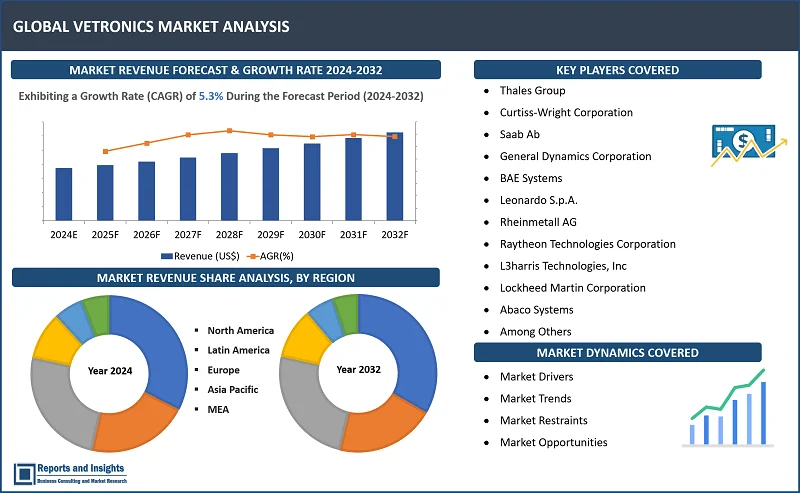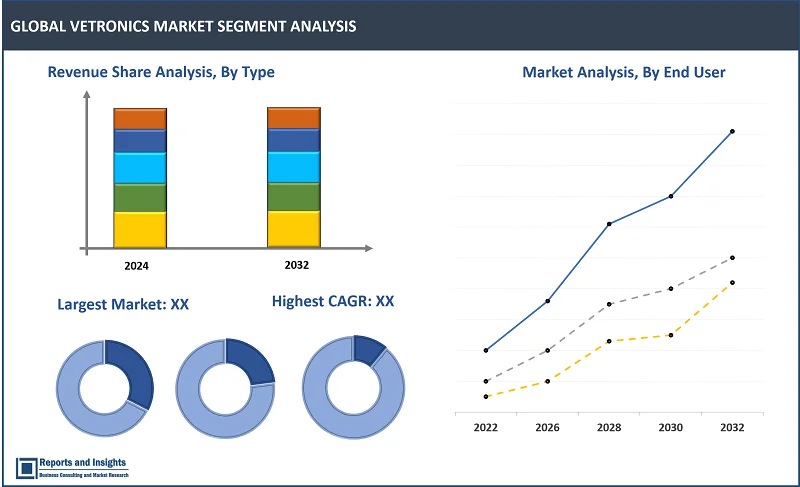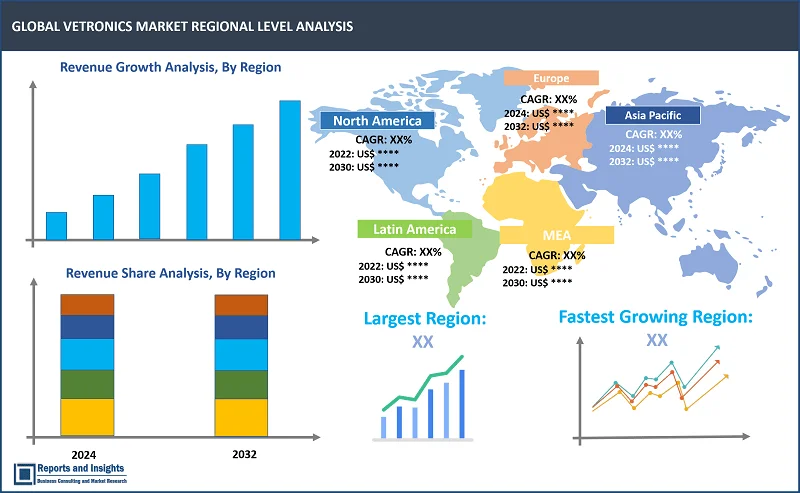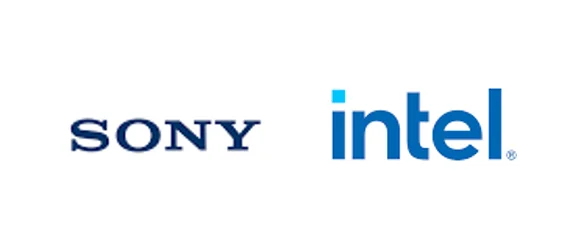Market Overview:
"The vetronics market was valued at US$ 5.7 Billion in 2023, and is expected to register a CAGR of 5.3% over the forecast period and reach US$ 9.1 Bn in 2032."
|
Report Attributes |
Details |
|
Base Year |
2023 |
|
Forecast Years |
2024-2032 |
|
Historical Years |
2021-2023 |
|
Vetronics Market Growth Rate (2024-2032) |
5.3% |
Vetronics, a portmanteau of "vehicle" and "electronics," portrays the leading-edge integration of advanced electronic systems in military vehicles. These advanced technologies surrounds an extensive range of components, including cameras, sensors, communication systems, and control interfaces, focused at improving the operational capabilities and survivability of military platforms. In present day’s swiftly evolving battlefield outlook, vetronics hold an integral role in offering situational awareness, supporting command and control functions, and ensuring mission success. The global market for vetronics is experiencing strong growth, led by growing defence spending, technological breakthroughs, and the modernization of military fleets across the globe. As nations invest in next-generation armoured vehicles and combat platforms, the demand for avant-garde vetronics solutions continues to rise. In addition, the consolidation of machine learning, artificial intelligence, and unmanned systems into vetronics further accelerates market expansion, promising improved effectiveness, efficiency, and lethality on the battlefield. In this dynamic panorama, vetronics emerge as a crucial enabler of modern warfare, redefining military operations and fueling innovation in defence electronics.
In the global vetronics market, technological progresses and surfacing trends are refurbishing military vehicle electronics. Innovations such as unmanned systems, artificial intelligence, and advanced sensors are transforming battlefield capabilities, offering improved situational awareness, autonomous operation, and integrated command and control functions. In addition, there is a soaring focus on ruggedized, modular, and scalable solutions to accommodate diverse mission requirements and platforms. Moreover, the blend of connectivity technologies and data analytics enables real-time decision-making and predictive maintenance, optimizing vehicle performance and mission readiness. These innovations herald a new era of vetronics, marked by greater automation, efficiency, and interoperability in modern military operations.

Vetronics Market Trends and Drivers:
One of the primary drivers of the global vetronics market is the year-on-year rise in global defense budget expenditure, accelerated by nations such as the United States, Russia, China, and India. These countries distribute considerable budgets toward the acquisition and modernization of their military vehicles, including armoured personnel carriers, tanks, and infantry fighting vehicles, fuelling demand for vetronics solutions.
In addition, the growing intricacy of modern warfare scenarios, marked by asymmetric threats and urban operations, requires the incorporation of sophisticated electronic systems into military platforms to improve situational awareness, survivability, and lethality. Moreover, the soaring emphasis on network-centric warfare and digitization initiatives further propels the adoption of vetronics, allowing seamless communication, coordination, and synchronization of battlefield operations.
Besides that, the trend towards modular and scalable vetronics solutions allows for easier integration and upgrades, improving flexibility and adaptability to evolving mission requirements. Also, the emergence of hybrid and electric propulsion systems in military vehicles offers new opportunities for vetronics integration, promoting energy-efficient operation and lowering logistical burdens.
Vetronics Market Restraining Factors:
The global vetronics market also witnesses few restraints that could hinder its growth and development. One fundamental challenge is the extravagant cost associated with the development, integration, and maintenance of advanced electronic systems in military vehicles. The intricacy of vetronics solutions necessitates signficant investment in research and development, as well as specialized manufacturing processes, resulting in higher procurement costs. In addition, stringent regulatory needs and compliance standards impose further financial strains on manufacturers. Moreover, interoperability issues among various vetronics systems and platforms can hamper seamless integration and communication, impeding the effectiveness of military operations. Additionally, cybersecurity threats presents a substantial risk to vetronics systems, needing robust security measures to safeguard sensitive data and avoid cyber-attacks.
Vetronics Market Opportunities:
One leading opportunity lies in the surging demand for integrated and interoperable electronic systems in military vehicles. With the evolution of modern warfare scenarios, there is a soaring need for vetronics solutions that offer improved situational awareness, communication capabilities, and mission flexibility. Manufacturers have the opportunity to develop advanced technologies that allow seamless integration and interoperability among various electronic systems, supporting efficient command and control operations on the battlefield.
Furthermore, the advent of unmanned systems and autonomous vehicles further offer new opportunities for vetronics integration. Since militaries around the world invest in unmanned platforms for surveillance, reconnaissance, and combat missions, there is a substantial demand for vetronics solutions customized to these unmanned systems. This comprises advanced sensor technologies, autonomous navigation systems, and communication interfaces optimized for unmanned operations. Overall, the expanding scope of military modernization efforts and the increasing complication of battlefield environments present promising opportunities for vetronics manufacturers to innovate and capture market share.
Vetronics Market Segmentation:

By Vehicle Type
- Main Battle Tank
- Light Combat Vehicles
- Armoured Personnel Carriers
- Infantry Fighting Vehicle
- Others
The light combat vehicle segment is anticipated to grow at the highest rate in the global vetronics market due to increasing demand for agile and manoeuvrable vehicles in modern warfare scenarios, emphasizing mobility, versatility, and rapid deployment capabilities.
By Platform
- Homeland Security
- Military
The military segment holds the largest share in the global vetronics market due to extensive adoption of advanced electronic systems in military vehicles for enhancing situational awareness, communication, and combat capabilities in various defense operations and missions.
By System
- Weapon and Control System
- Command and Communication
- Navigation and Display
- Sensor and Optronics
- Power System
- Others
The navigation and display segment holds a prominent market share in the global vetronics market due to the critical role of navigation systems and display interfaces in providing real-time situational awareness, precise location tracking, and effective communication for military vehicles in diverse operational environments.
By Region

North America
- United States
- Canada
Europe
- Germany
- United Kingdom
- France
- Italy
- Spain
- Russia
- Poland
- Benelux
- Nordic
- Rest of Europe
Asia Pacific
- China
- Japan
- India
- South Korea
- ASEAN
- Australia & New Zealand
- Rest of Asia Pacific
Latin America
- Brazil
- Mexico
- Argentina
Middle East & Africa
- Saudi Arabia
- South Africa
- United Arab Emirates
- Israel
- Rest of MEA
The global Vetronics market is divided into five key regions: North America, Europe, Asia Pacific, Latin America, and the Middle East and Africa. The Asia-Pacific region is projected to witness the most rapid growth in the global vetronics market throughout the forecast period, primarily fuelled by increased procurement initiatives and associated orders. Escalating tensions among neighbouring nations, notably the South China Sea dispute, are prompting adjacent countries to bolster their military capabilities by swiftly acquiring military vehicles.
Leading Vetronics Providers & Competitive Landscape:
In the competitive landscape of the global vetronics market, key players are employing various strategies to maintain their positions and gain a competitive edge. These strategies include product innovation, strategic partnerships, mergers and acquisitions, and geographic expansions. Major players focus on developing advanced vetronics solutions that integrate cutting-edge technologies to meet evolving military requirements. Additionally, partnerships with defense contractors, government agencies, and technology providers facilitate access to new markets and enhance product offerings. Furthermore, mergers and acquisitions enable companies to expand their product portfolios and consolidate market share. Overall, the market is characterized by intense competition, innovation-driven growth, and strategic collaborations among key players striving to capitalize on emerging opportunities in the dynamic defense electronics industry.
These companies include:
- Thales Group
- Curtiss-Wright Corporation
- Saab Ab
- General Dynamics Corporation
- BAE Systems
- Leonardo S.p.A.
- Rheinmetall AG
- Raytheon Technologies Corporation
- L3harris Technologies, Inc
- Lockheed Martin Corporation
- Abaco Systems
- Hanwha Systems Co., Ltd.
- Krauss-Maffei Wegmann GmbH & Co. KG
Vetronics Market Research Scope
|
Report Metric |
Report Details |
|
Vetronics Market Size Available for the Years |
2021-2023 |
|
Base Year |
2023 |
|
Forecast Period |
2024-2032 |
|
Compound Annual Growth Rate (CAGR) |
5.3% |
|
Segments Covered |
Vehicle Type, Platform, System, and Regions |
|
Regions Covered |
North America: The U.S. & Canada Latin America: Brazil, Mexico, Argentina, & Rest of Latin America Asia Pacific: China, India, Japan, Australia & New Zealand, ASEAN, & Rest of Asia Pacific Europe: Germany, The U.K., France, Spain, Italy, Russia, Poland, BENELUX, NORDIC, & Rest of Europe The Middle East & Africa: Saudi Arabia, United Arab Emirates, South Africa, Egypt, Israel, and Rest of MEA |
|
Fastest Growing Country in Europe |
Germany |
|
Largest Market |
North America |
|
Key Players |
Thales Group, Curtiss-Wright Corporation, Saab Ab, General Dynamics Corporation, BAE Systems, Leonardo S.p.A., Rheinmetall AG, Raytheon Technologies Corporation, L3harris Technologies, Inc, Lockheed Martin Corporation, among others |
Frequently Asked Question
What is the market size of the vetronics market in 2023?
The Vetronics market size reached US$ 5.7 Billion in 2023.
At what CAGR will the vetronics market expand?
The market is expected to register a 5.3% CAGR through 2024-2032.
Which is the fastest growing country in Europe?
Germany is the fastest growing country in Europe.
What are some key factors driving revenue growth of the vetronics market?
Some key factors driving revenue growth are year-on-year rise in global defense budget expenditure, and growing intricacy of modern warfare scenarios among others.
What are some major challenges faced by adopters of vetronics solutions?
Some key challenges include extravagant cost associated with the development, integration, and maintenance of advanced electronic systems in military vehicles.
How is the competitive landscape in the vetronics market?
The competitive landscape in the vetronics market is dynamic with focus on product innovation, strategic partnerships, mergers and acquisitions, and geographic expansions.
How is the vetronics market segmented?
The market report is segmented based on vehicle type, platform, system, and regions.
Which top companies are included in the global Vetronics market report?
Thales Group, Curtiss-Wright Corporation, Saab Ab, General Dynamics Corporation, BAE Systems, Leonardo S.p.A., Rheinmetall AG, Raytheon Technologies Corporation, L3harris Technologies, Inc, Lockheed Martin Corporation, Others.

